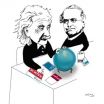(Press-News.org) There appears to be no link between chronic cerebrospinal venous insufficiency and multiple sclerosis (MS), according to new research published in CMAJ (Canadian Medical Association Journal).
In 2009, Dr. Paolo Zamboni postulated that chronic cerebrospinal venous insufficiency is a cause of MS, an inflammatory disease of the central nervous system that affects people in northern climates in particular. Published evidence has not been able to find a link to MS, and no one has been able replicate his findings. Several recent studies have shown an association between ultrasound-diagnosed chronic cerebrospinal venous insufficiency and MS but results vary widely.
Using ultrasound technology and magnetic resonance venography, researchers undertook a study to explore the validity of the theory that chronic cerebrospinal venous insufficiency and MS are linked. They enrolled 120 patients with MS and 60 healthy controls. A high percentage of patients (58%) and controls (63%) met one or more proposed ultrasound criteria that would help diagnose chronic cerebrospinal venous insufficiency although there were no differences seen between groups.
"We detected no link between chronic cerebrospinal venous insufficiency and multiple sclerosis," writes Dr. Fiona Costello, departments of Clinical Neurosciences and Surgery, University of Calgary, Calgary, Alberta, with coauthors.
They cite concerns over the diagnosis of chronic cerebrospinal venous insufficiency.
"We also identified several methodologic concerns that challenge the validity of the criteria used to define chronic cerebrospinal venous insufficiency, and in turn we dispute the authenticity of this diagnosis."
INFORMATION:
No apparent link between chronic cerebrospinal venous insufficiency and MS
2014-06-02
ELSE PRESS RELEASES FROM THIS DATE:
Fishing boats are powerful seabird magnets
2014-06-02
It's no surprise that seabirds are attracted to fishing boats, and especially to the abundance of discards that find their way back into the ocean. But researchers reporting in the Cell Press journal Current Biology on June 2 now find that those boats influence bird behavior over much longer distances than scientists had expected.
Specifically, each boat creates a "halo of influence" across an area measuring about 22 kilometers. That's 13.6 miles—a distance a little longer than a half marathon.
"While we knew that seabirds, including gannets, regularly followed fishing ...
Success for scientists in the academic job market is highly predictable
2014-06-02
The number of scientists in training vastly exceeds the number that will successfully land a faculty position at an academic institution. Now, researchers report in the Cell Press journal Current Biology on June 2 that an individual scientist's chances are very predictable based solely on his or her publication record.
The likelihood of getting that faculty job depends mostly on the number of publications, the impact factor of the journals in which those papers are published, and the number of papers that receive more citations than would be expected based on the journal ...
Gannet sat nav reveals impact of fishing vessels
2014-06-02
Fishing vessels have a far bigger ecological footprint than previously thought, according to research which tracked the movement and behaviour of seabirds using GPS devices.
A team of scientists led by the University of Exeter discovered that northern gannets change their behaviour in response to the presence of large vessels such as trawlers, suggesting each boat can significantly influence the distribution and foraging patterns of these and other marine predators.
Northern gannets (Morus bassanus) are known to feed on discards from fishing vessels as well as diving ...
Rolling old river is indeed changing
2014-06-02
This release is also available in Chinese on EurekAlert! Chinese.
The Hudson River has changed in many far-reaching ways over the past quarter-century as a result of human activity, reports a team of researchers in the June issue of BioScience. Zebra mussels and other invasive species have changed the river's ecology—although the influence of the zebra mussels now seems to be waning.
A 40 percent increase in the freshwater flow has also had powerful effects, and these seem to be countering the effects of higher temperatures, especially in summer. Pollution by chlorinated ...
No harm in yoga: But not much help for asthma sufferers
2014-06-02
ARLINGTON HEIGHTS, Ill. (May 29, 2014) – Yoga has long been promoted as a method for improving physical and mental well-being. And although yoga is often suggested to asthma sufferers to help alleviate symptoms, a new study found little evidence that yoga will improve symptoms.
Researchers of the report, which is published in the June issue of Annals of Allergy, Asthma & Immunology, the scientific journal of the American College of Allergy, Asthma and Immunology (ACAAI), examined 14 previously published studies to determine the effectiveness of yoga in the treatment of ...
New launchers for analyzing resistance to impacts and improving armor plating
2014-06-02
This news release is available in Spanish. At these specialized facilities, which are linked to the UC3M-Airbus Group Joint Center, scientists are studying how structural elements react to applied loads at both low and high speeds. Phenomena of this sort can occur during maintenance operations (a tool falling in an aircraft) or while the elements are functioning. In the case of an airplane, for example, it can happen when a pebble hits an airplane during takeoff, or when a slab of ice comes off of a propeller or the leading edge of a wing and hits the fuselage.
"Our ...
Nano world: Where towers construct themselves
2014-06-02
This news release is available in German. Imagine a tower builds itself into the desired structure only by choosing the appropriate bricks. Absurd – and however, in the nano world this is reality: There an unordered crowd of components can initiate the formation of an ordered structure – a process known as self-assembly. The physicists Christos Likos (University of Vienna), Emanuela Bianchi and Gerhard Kahl (both Vienna University of Technology) investigate how they can control the ordering of such self-assembling structures and found out how to switch the assembly ...
Physicist builds useful light source from harmonic generation
2014-06-02
MANHATTAN, KANSAS — A Kansas State University physicist's proposal may lead to a new way of creating tabletop light sources in the laboratory.
Cheng Jin, research associate in physics; Chii-Dong Lin, university distinguished professor of physics; and collaborators are developing a way to greatly enhance the generation of high-order harmonics to create powerful small tabletop light sources that are important to science and technology.
The researchers are building theoretical framework and providing experimental guidance in the area of strong-field physics. The work is ...
CU Denver study shows public health often ignored in transportation policy
2014-06-02
DENVER (June 2, 2014) – A new study from the University of Colorado Denver shows public health issues are often ignored in many transportation projects, especially when major roads are built through lower-income neighborhoods.
Air pollution, crime and numerous traffic hazards, the study said, point to a serious and persistent gap between public health and planning.
"The public health effects of heavy traffic are broad," said study author Carolyn McAndrews, PhD, assistant professor at the CU Denver College of Architecture and Planning, one of the largest schools of its ...
Surgeons report fewer postoperative blood clots using risk-based preventive measures
2014-06-02
Chicago (June 2, 2014): Surgery patients are much less likely to get a blood clot in the lower extremities or lungs if they receive preventive treatment based on their individual clotting risk, in addition to walking soon after the operation. Results from a surgical quality improvement study, appearing in the June issue of the Journal of the American College of Surgeons, indicate that the odds of this common and potentially life-threatening postoperative complication steadily declined after the implementation of a multicomponent prevention program in a hospital's department ...





